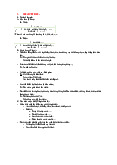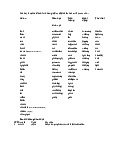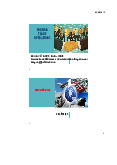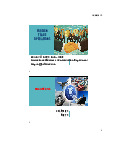






Preview text:
HOCHIMINH CITY UNIVERSITY OF FOREIGN LANGUAGES
AND INFORMATION TECHNOLOGY
DEPARTMENTOF INTERNATIONAL BUSINESS ADMINISTRATION ---------***--------
SCIENCE APPLICATION ARCHITECTURE WORKS
Student’s name 1: LÊ THỊ LAN TRINH
Student’s name 2: HOÀNG MAI KHANH
Student’s name 3: PHẠM VƯơNG ÁNH LINH
Student’s name 4: NGUYỄN HẠ VI
Magnificent biomimicry architecture 1. Anti-Smog Building, Paris
The building consists of two main parts: Solar Drop and Wind Tower
The Anti-Smog building is one of the projects of Vincent Callebaut, a
young French engineer who has created a real craze around the world
about bio-damaged buildings. The project consists of two han: The central
part is the Solar Drop - an elliptical building built on an old railway track
in the Parisan district. The dome is 250 m wide with photovoltaic panels to
help produce electricity from sunlight, and outside is also covered with
titanium dioxide (TiO2) for the purpose of using ultraviolet radiation to
affect the elements. particles in the air, breaking down the structure and
reducing the pollutant components in the air 2. Bionic architecture
Bionic architecture is an architectural trend that applies biological
simulation techniques research, bringing architecture closer to the natural world.
Bionic architecture pushes away the rigid shape of buildings'
communication systems, replacing
which uses curves of biological structures as well as lines
naturally curved. Therefore, these structures all give shapes
very unique, designed based on a very complex calculation of
mathematical and natural (biology). Urban Cactus
Those are environmentally friendly and optimized constructions in terms of:
• Use energy, water and various resources efficiently.
• Protect user's health and improve labor productivity.
• Reduce quality, pollution and environmental damage. 3. Use of solar energy Hyperion Building, India
The building is designed according to the "self-sufficient" model designed
by Belgian architect Vincent Callebaut as an eco-friendly building with
green gardens that can produce fruit and vegetables. Organic useful
vegetables, small livestock farms.
The house architecture will be equipped with solar panels. Energy for the
indoor components is generated through wind turbines and photovoltaic
systems. In addition, the dependent agricultural products from the farms
will be converted into methane gas to generate energy used in the building.
Rainwater will be the fall for the harvest and to replenish the rainwater.
The work is expected to be completed this year.
4.Niels Bohr and the Atomic Model
Niels Henrik David Bohr was a Danish physicist whose foundational
contributions to the theory of atomic structure and early quantum mechanics,
for which he received the Nobel Prize in Physics in 1922. Bohr was also a
physicist. philosophy and actively promote scientific research activities.
Physicist Niels Bohr (1885-1962)
According to an article titled "Pillow-Talk: Seamless Interface for Dream Priming
Recalling and Playback" by Edwina Portocarrero at the Massachusetts Institute
of Technology (MIT) and co-authors say:
“Niels Bohr said he developed an atomic model based on a dream in which he
sat on the Sun with all the planets flying around it on small ropes.”
When he woke up, he conducted research and built an atomic model consisting
of a small positively charged nucleus and electrons moving around in different
orbits. This is similar to the structure of the Solar System, but the gravitational
force is replaced by the electrostatic force.




